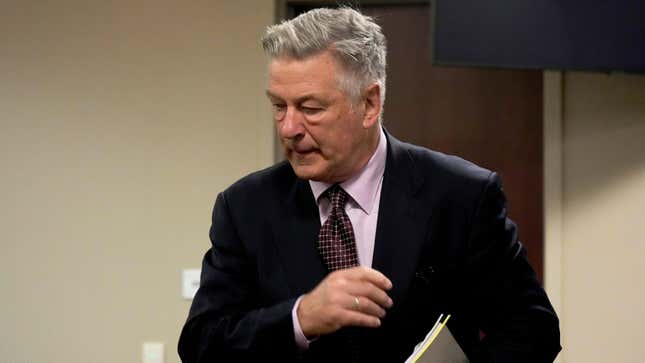
Three years out from the shooting on the set of Rust, Alec Baldwin is finally on trial for involuntary manslaughter in the death of cinematographer Halyna Hutchins. The entire case has been, generously, a mess from the beginning, from the rumored chaos behind the scenes of the film, to Baldwin’s public insistence that he never pulled the trigger of his prop gun, to the prosecution’s reportedly sloppy investigation. In opening arguments on day one of the trial, both the prosecution and defense attempted to explain away the biggest weaknesses of their cases.
For the prosecution, their smoking gun is quite literally a smoking gun. Special prosecutor Erlinda Johnson stated repeatedly that the prop gun Baldwin was wielding was, for all intents and purposes, a real gun that became deadly when a real bullet was loaded into it, and that after the shooting the gun underwent several rounds of testing to ensure that it would have been safe to use under the correct circumstances. But the prosecution’s major problem is that the original gun used on the Rust set was irreparably damaged by investigators, an issue that seemed to lead to charges against Baldwin being dropped back in April 2023. Now, Johnson said that the gun was only damaged because the FBI approved an accidental discharge test, one which supposedly confirmed that the gun had been in working order. For their argument, whatever damage the gun incurred is beside the point, because the “fatal and one of the main problems” is that Baldwin didn’t check the gun himself and pulled the trigger “in reckless disregard for Ms. Hutchins’ safety.”
Though Baldwin was a producer on what sounds like an awfully chaotic set, he’s being tried for his actions as an actor. And as an actor, the defense argued, he should be allowed to act in character with the reasonable assumption that the prop weapon he’s holding won’t harm or kill anyone. “Safety is ensured before the actor,” said defense lawyer Alex Spiro, and the gun was checked by armorer Hannah Gutierrez-Reed and first assistant director Dave Halls before handing it over to Baldwin. Further, Halls called “cold gun,” meaning it should have been “impossible” for anyone to be hurt by the weapon. As for the defense’s biggest weakness—Baldwin’s assertion he didn’t pull the trigger—his lawyer suggested that even if he may have misspoken or misremembered about cocking the gun, that doesn’t mean he committed any crime. Baldwin was simply doing his job by acting and pulling the trigger “in ways that would be lethal in the real world, but are not lethal on a movie set.” No one “batted an eye” at his rehearsals that day until the fatal incident occurred.
The prosecution interrupted the defense’s opening argument multiple times, while the defense cast some serious aspersions on how the prosecution has handled the case. As Spiro pointed out, the biggest question in the Rust case remains: how did actual live rounds end up on a movie set? As that question is still unanswered, Spiro argued that “Instead of trying to find the source of the lethal bullet,” investigators “focused on Mr. Baldwin” because he’s a famous actor in the middle of a high-profile tragedy. The “destruction of the gun is symbolic of the entire case,” Spiro said, as prosecutors were no longer attempting to investigate, but instead simply trying to disprove Baldwin’s version of events. The trial is expected to run until Friday, July 19.